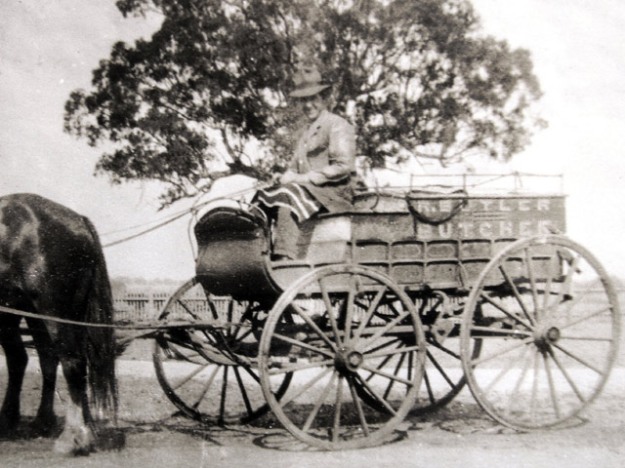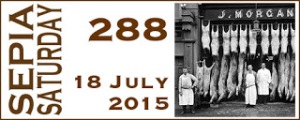A butcher’s shop from Sepia Saturday to inspire us this week. Or perhaps, pigs, or shops, or white aprons, or whatever rises to the surface on viewing this image.
So I will return to an image I have used before, that of Robert Butler, farmer and butcher of Moolort then Newstead in Central Victoria, and his mobile butcher’s cart. He married my great aunt Eliza Fricke in 1901
 But I had never stopped to consider what the inside of the cart might have looked like until recently I saw this image of a butcher’s cart which served a similar purpose.
But I had never stopped to consider what the inside of the cart might have looked like until recently I saw this image of a butcher’s cart which served a similar purpose.
This is a 1920s photo of butcher Bert Fahey, with the cart belonging to a Mr Rettke, possibly in the Camperdown, Murchison or Shepparton districts and was posted in Lost Country Victoria by Bert’s son. The butcher is about to sharpen his knife on a sharpening steel and has some spring scales hanging from the roof of the cart ready to weight the meat.
I have a feeling that I might turn vegetarian if I had to buy my meat in this fashion.
But I am having trouble concentrating on all things related to butchers at the moment as it seems to be that time of year when Ant School from somewhere around my place is in Work Experience week. In summer you come to expect the occasional trail of well-organized mature little fellows going Hup, two, three, four, Hup, two, three, four making a beeline for the kitchen. But in Work Experience Week it is just these little groups of untested baby ants being sent out on reconnaissance missions to see how they go. They soon come to a very unfortunate end but no-one comes looking for them, they have failed, they are expendable. And when they don’t return another little group ventures out along a slightly different route, only to meet with the same fate. Poor little ants.
More butchers, pigs, shops etc, but probably no ants, will be found in this week’s Sepia Saturday post.



A mobile butcher! From the looks of the wagon, I suppose they brought already-butchered meat to the customer. I wonder if they also butchered a customer’s cow or pig at the farm for them.
LikeLike
I think those old traditionsl navy striped aprons would have been good for not showing up the blood stains as much as white aprons. At least butchers these days don’t generally have to kill the animals themselves.
LikeLike
What an absolutely fascinating pair of photos.One shudders to think about the infection control implications of such a set-up. But people didn’t seem to suffer that much.
LikeLike
Ants are something that we don’t have much of a problem with around here, thank goodness. Too cold, I guess. Thanks for the photos of the butcher’s cart – most interesting, and I’ll be on the look out for similar carts in other photos now.
LikeLike
I never encountered the travelling butcher but I do recall a Chinese gentleman with a horse-drawn wagon calling around the streets of Bentleigh and East Brighton with vegetables grown in the Chinese market gardens of East Bentleigh.
LikeLike
Oh yes, ants are so industrious. I’ve finally got mine away from my home. Loved the butchers cart photo…probably providing meats to those who didn’t go to market daily…before refrigeration. Thanks for an interesting post!
LikeLike
What a great family connection with this week’s theme of butchers. But what was the temperature control like in those carts? I don’t know if I would fancy eating meat transported in hot weather in that kind of way. .
Family History Fun
LikeLike
Could there be an ice box in the carts? I once bought ribeye steaks from some guy with a freezer box in the back of his pickup truck. They were not grade A, or even grade B!
If you want to see the new ant invasions we have in America, google “Rasberry crazy ants” or “Fire ants”. Both pests are expanding rapidly across the south.
LikeLike
I’m struggling to imagine how a mobile butcher run worked. Most of the farming community killed and butchered their own animals and people living in towns bought from the butcher in the main street.
Robert Butler’s cart is certainly sturdy.
LikeLike